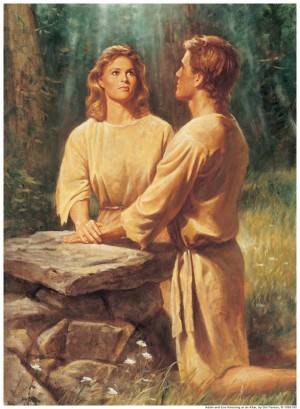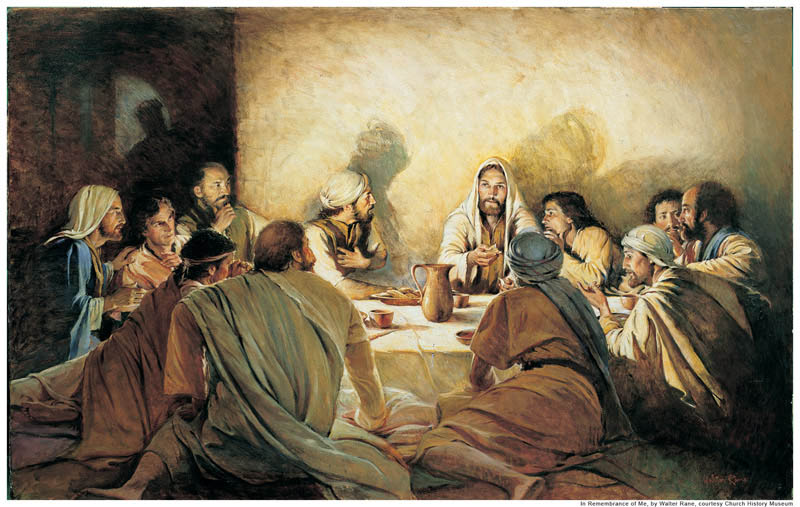by Terrie Lynn Bittner | Dec 6, 2012 | Mormon Beliefs: Christian Values
It’s always a challenge for Mormons when someone asks them if they are saved. The answer isn’t a simple yes or no, because Mormons don’t believe you can be saved by saying the right words and being done with it. It is a life-long event for Mormons, and so they might more correctly answer, “I’ve taken the first steps and now I’m working on continuing faithfully to the end.”
In 1998, Dallin H. Oaks, a Mormon apostle, wrote a response to this question that effectively outlines how Mormons (a nickname for members of The Church of Jesus Christ of Latter-day Saints) use the word saved. In order to understand another faith accurately, you have to “speak their language.” I’ll be referring to Elder Oaks’ talk as I discuss this topic. You can read the complete talk here: (more…)

by brady | Dec 19, 2011 | Mormon Beliefs: Christian Values
Encyclopedia of Mormonism summarizes Eve’s role in the Fall as follows:
Satan was present to tempt Adam and Eve, much as he would try to thwart others in their divine missions: “and he sought also to beguile Eve, for he knew not the mind of god, wherefore he sought to destroy the world” (Moses 4:6). Eve faced the choice between
 selfish ease and unselfishly facing tribulation and death (Evidences and Reconciliations, by John A. Widtsoe, page 193). As befit her calling, she realized that there was no other way and deliberately chose mortal life so as to further the purpose of god and bring children into the world. (s.v. “Eve”)
selfish ease and unselfishly facing tribulation and death (Evidences and Reconciliations, by John A. Widtsoe, page 193). As befit her calling, she realized that there was no other way and deliberately chose mortal life so as to further the purpose of god and bring children into the world. (s.v. “Eve”)
Elder Dallin H. Oaks taught about the vital contribution of Eve in partaking of the fruit and of the difference between transgression and sin.
It was Eve who first transgressed the limits of Eden in order to initiate the conditions of mortality. Her act, whatever its nature, was formally a transgression but eternally a glorious necessity to open the doorway toward eternal life. Adam showed his wisdom by doing the same. And thus Eve and “Adam fell that men might be” (2 Ne. 22:25). (more…)

by brady | Dec 19, 2011 | Mormon Beliefs: Christian Values
Were Adam and Eve Cursed?
The answer to this question is no. Unfortunately, many view the Fall as having brought a curse upon both Adam and Eve. Such a view casts a false negative light on the fairness of the work of god. Such people mistakenly tend to use the scriptures that describe the scene right after the partaking of the forbidden fruit to teach that the Fall was a very negative thing, with resulting curses on Eve and also on Adam. They even engage in debates as to who got the worst curse, Adam or Eve. In so doing, they sadly and badly misinterpret the scriptures. The fact is that neither Adam nor Eve was cursed. The Fall was good for them and good for us. It worked in harmony with the Atonement. Satan was cursed and the earth was cursed “for their sake.” We will read the relevant verses and add some commentary as we go. First, we see that Satan was cursed.
 14 And the Lord god [the Father] said unto the serpent, Because thou hast done this, thou art cursed above [limited more than] all cattle, and above every beast of the field [one aspect of this curse is that even “cattle” and “every beast of the field” get a physical body to go with their spirit; Satan will never get a physical body]; upon thy belly shalt thou go [Satan will be looked upon as the lowest of the low], and dust shalt thou eat all the days of thy life [perhaps meaning that he will always be behind the Savior, in effect, “eating the Savior’s dust”; this could also be a play on words, saying, in effect, that Satan will be “eating dust,” in other words, associating with mortals, trying to swallow them up in spiritual destruction, but never receive a mortal body himself, one made of the “dust of the ground”—see Moses 3:7]: (more…)
14 And the Lord god [the Father] said unto the serpent, Because thou hast done this, thou art cursed above [limited more than] all cattle, and above every beast of the field [one aspect of this curse is that even “cattle” and “every beast of the field” get a physical body to go with their spirit; Satan will never get a physical body]; upon thy belly shalt thou go [Satan will be looked upon as the lowest of the low], and dust shalt thou eat all the days of thy life [perhaps meaning that he will always be behind the Savior, in effect, “eating the Savior’s dust”; this could also be a play on words, saying, in effect, that Satan will be “eating dust,” in other words, associating with mortals, trying to swallow them up in spiritual destruction, but never receive a mortal body himself, one made of the “dust of the ground”—see Moses 3:7]: (more…)

by brady | Dec 19, 2011 | Mormon Beliefs: Christian Values
The Fall of Adam and Eve
The Atonement cannot be properly understood without an understanding of the Fall. The two go hand in hand. The Fall refers to the partaking of the forbidden fruit by Adam and Eve in the garden of Eden and their being cast out of the garden into mortal life (genesis 3). It can be said that they “fell forward.” It was a necessary and planned step in the Father’s plan of salvation for us. It brought with it physical death and also brought spiritual death (being cut off from the direct physical presence of god). The Atone- ment of Jesus Christ overcomes physical death for all, through the universal resurrection of the dead (1 Corinthians 15:22). It also makes it possible for those who will to repent and overcome spiritual death and thus return to the physical presence of the Father, to live with Him forever in celestial glory.
 While other churches teach that the Fall was a terrible tragedy and brought unfortunate misery upon all mankind, the true gospel teaches that it was good and is a great blessing for all of us. While many churches criticize and even vilify Adam and Eve, especially Eve, for partaking of the forbidden fruit, we honor them and hold them in highest esteem for taking this vital step which opened the door for all of us to come to earth. The fact that the Fall was good and was part of the Father’s plan is clearly taught by Lehi in the Book of Mormon as he gives a brief and concentrated overview of the Fall and Atonement. As you read the verses quoted next, note the important points emphasized by the Savior through His prophet, Lehi, including: (more…)
While other churches teach that the Fall was a terrible tragedy and brought unfortunate misery upon all mankind, the true gospel teaches that it was good and is a great blessing for all of us. While many churches criticize and even vilify Adam and Eve, especially Eve, for partaking of the forbidden fruit, we honor them and hold them in highest esteem for taking this vital step which opened the door for all of us to come to earth. The fact that the Fall was good and was part of the Father’s plan is clearly taught by Lehi in the Book of Mormon as he gives a brief and concentrated overview of the Fall and Atonement. As you read the verses quoted next, note the important points emphasized by the Savior through His prophet, Lehi, including: (more…)

by | Nov 29, 2011 | About Mormons, Mormon Beliefs: Christian Values
By Eric Kotter, a member of The Church of Jesus Christ of Latter-day Saints (“Mormon“). A student at BYU-Idaho studying communications, and freelance writer.
When Jesus Christ was on the earth He gave bread and wine to His twelve apostles and said, “This is my body which is given for you: this do in remembrance of me. Likewise also the cup after supper, saying, This cup is the new testament in my blood, which is shed for you” (Luke 22:19-20).
Holy Communion: A Symbol of Jesus Christ’s Atoning Sacrifice
 As a member of The Church of Jesus Christ of Latter-day Saints (inadvertently called by friends of other faiths, the “Mormon Church”) I participate each week during worship services in an ordinance called the sacrament. The sacrament is similar to Holy Communion which many other faiths participate in. One difference between the Holy Communion that Mormons participate in, and Catholic Communion, is that we do not believe in the doctrine of transubstantiation, which is a belief that the bread and wine literally turn into the blood and body of Jesus Christ as the person partakes. We believe that Jesus Christ instituted the sacrament, the bread and wine, to represent His body and blood, which were given to us as a sacrifice to lift the burden and judgments of our sins, trials and weaknesses as we follow Him. We partake of the sacrament as symbols of what He did for us. Partaking of the sacrament is a blessing Jesus Christ gave to His followers so they can renew their baptismal covenants to follow Him that they might become clean from their sins.
As a member of The Church of Jesus Christ of Latter-day Saints (inadvertently called by friends of other faiths, the “Mormon Church”) I participate each week during worship services in an ordinance called the sacrament. The sacrament is similar to Holy Communion which many other faiths participate in. One difference between the Holy Communion that Mormons participate in, and Catholic Communion, is that we do not believe in the doctrine of transubstantiation, which is a belief that the bread and wine literally turn into the blood and body of Jesus Christ as the person partakes. We believe that Jesus Christ instituted the sacrament, the bread and wine, to represent His body and blood, which were given to us as a sacrifice to lift the burden and judgments of our sins, trials and weaknesses as we follow Him. We partake of the sacrament as symbols of what He did for us. Partaking of the sacrament is a blessing Jesus Christ gave to His followers so they can renew their baptismal covenants to follow Him that they might become clean from their sins.
In the Doctrine and Covenants, a book of modern revelation given by God, the Lord gave us the purpose of the sacrament. The Lord said, “And that thou mayest more fully keep thyself unspotted from the world, thou shalt go to the house of prayer and offer up thy sacraments upon my holy day” (Doctrine and Covenants 59:9). (more…)




 14 And the Lord god [the Father] said unto the serpent, Because thou hast done this, thou art cursed above [limited more than] all cattle, and above every beast of the field [one aspect of this curse is that even “cattle” and “every beast of the field” get a physical body to go with their spirit; Satan will never get a physical body]; upon thy belly shalt thou go [Satan will be looked upon as the lowest of the low], and dust shalt thou eat all the days of thy life [perhaps meaning that he will always be behind the Savior, in effect, “eating the Savior’s dust”; this could also be a play on words, saying, in effect, that Satan will be “eating dust,” in other words, associating with mortals, trying to swallow them up in spiritual destruction, but never receive a mortal body himself, one made of the “dust of the ground”—see Moses 3:7]:
14 And the Lord god [the Father] said unto the serpent, Because thou hast done this, thou art cursed above [limited more than] all cattle, and above every beast of the field [one aspect of this curse is that even “cattle” and “every beast of the field” get a physical body to go with their spirit; Satan will never get a physical body]; upon thy belly shalt thou go [Satan will be looked upon as the lowest of the low], and dust shalt thou eat all the days of thy life [perhaps meaning that he will always be behind the Savior, in effect, “eating the Savior’s dust”; this could also be a play on words, saying, in effect, that Satan will be “eating dust,” in other words, associating with mortals, trying to swallow them up in spiritual destruction, but never receive a mortal body himself, one made of the “dust of the ground”—see Moses 3:7]: 
